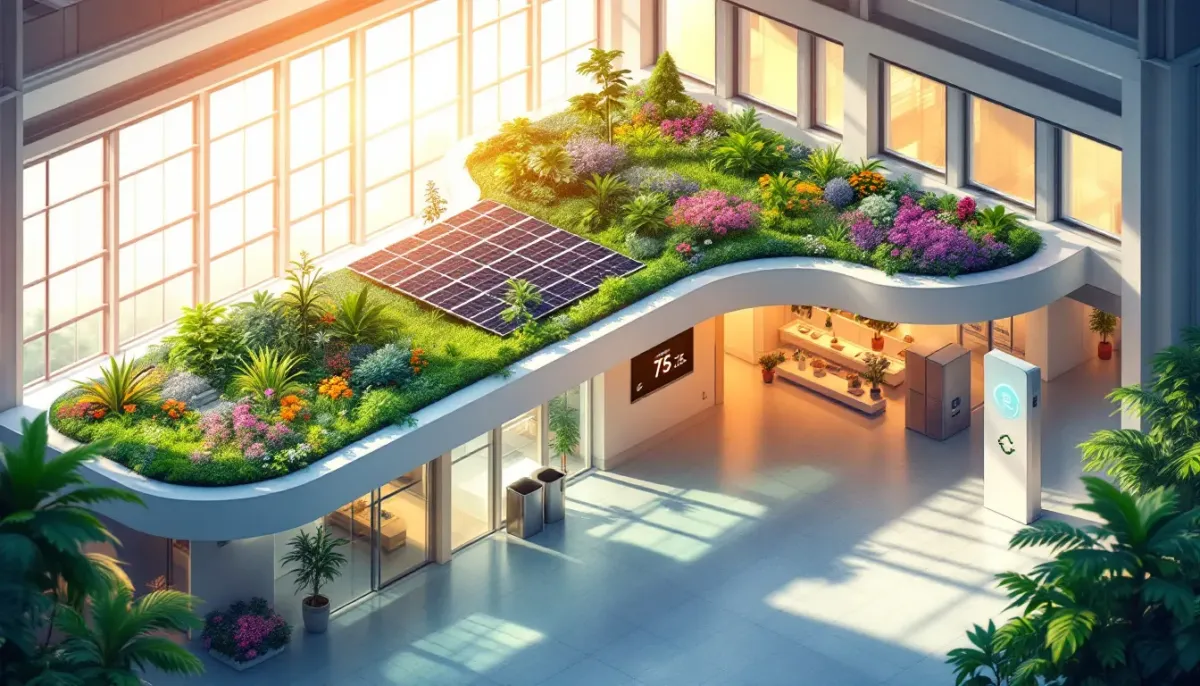Top 5 Energy-Saving Strategies for Large Facilities
Discover effective energy-saving strategies for large facilities that can significantly reduce costs and enhance sustainability.

Want to slash energy costs in your big building? Here's how:
- Upgrade heating and cooling
- Switch to LED lights
- Use smart building controls
- Improve insulation
- Install energy-saving appliances
These tricks can cut your energy use by 10-50%. Let's break it down:
| Strategy | Potential Savings |
|---|---|
| HVAC upgrade | 10-15% |
| LED lighting | Up to 80% |
| Smart controls | 30-50% |
| Better insulation | Up to 50% |
| Efficient appliances | 9-20% |
Big facilities gobble 40% of US energy. But small changes lead to big savings. Whether you run an office block or factory, these tips will help you save cash and go green.
Ready to dive in? Let's get started.
Improve Heating and Cooling Systems
Heating and cooling eat up a ton of energy in big buildings. Let's see how to make these systems work better, save money, and help the environment:
Energy Savings
Upgrading your HVAC can lead to serious savings:
- 10-15% cut in heating and cooling costs
- Nearly £140 yearly savings with ENERGY STAR equipment
- Smart thermostats can slash costs by up to 23%
Setup Costs
Upgrading isn't cheap, but it pays off:
| Upgrade | Cost |
|---|---|
| Smart thermostat | £150+ per unit |
| ENERGY STAR system | High upfront cost |
| Duct sealing | More cost-effective |
Upkeep Needs
Keep your HVAC running smoothly:
- Yearly pro check-ups
- Monthly air filter cleaning or changes
- Seal ducts to stop 20-30% air waste
Effects on Building Use
Better HVAC means better buildings:
- Happier occupants with better temperature control
- Cleaner air with HEPA filters and purifiers
- Heat or cool only rooms in use with zoning systems
"Building efficiency is a hot sector. Why? Because everyone wants lower costs, better reliability, and more resilience." - Kevin Self, Johnson Controls
Start by getting a pro to check your system. They'll help you decide between an upgrade or a few tweaks. Remember: in large facilities, small changes can lead to BIG savings.
2. Switch to LED Lights
LED lighting can slash energy costs for large facilities. Here's why:
Energy Savings
LEDs are super efficient:
- Use up to 80% less energy than old-school bulbs
- Cut lighting costs by 65-80%
- Slash CO2 emissions by over 90% vs incandescent
Setup Costs
LEDs cost more upfront but pay off fast:
| Bulb Type | Lifespan (hours) | Annual Energy Cost (50 bulbs, 2hrs/day) |
|---|---|---|
| Incandescent | 1,200 | £219 |
| LED | 25,000 | £36.50 |
Upkeep Needs
LEDs need way less maintenance:
- Last 50,000 to 100,000 hours (old bulbs? Just 2,000)
- Fewer replacements = lower labour costs
- No mercury, easier to toss out
Building Use Impact
LEDs do more than cut bills:
- Boost workplace safety and productivity
- Less heat = less strain on HVAC
- Use sensors to light only what's needed
Real results? King GMC Auto saved £40,000 yearly with LEDs. Crossroads Church? £70,578 in savings.
"LED upgrade hugely improved our lighting quality and brightness", said Northern Colorado Euro Motorcycles.
For big facilities, LEDs are a no-brainer that pays off big time.
3. Use Smart Building Controls
Smart building controls can slash energy use in large facilities. Here's how:
Smart systems cut waste big time:
- HVAC and lighting tweaks save 30-50% energy
- Overall electricity use drops 10-20%
- Smart lighting alone saves 35-40%
Upfront costs vary:
| Building Size | Estimated Cost Range |
|---|---|
| Small | £5,000 - £50,000 |
| Medium | £50,000 - £500,000 |
| Large | £500,000 - £5 million+ |
These systems need less hands-on care:
- Catch issues early with 24/7 monitoring
- Fix problems remotely, cutting site visits
- Predict maintenance needs, avoiding breakdowns
They also boost comfort and efficiency:
- Adjust temps and lighting based on occupancy
- Improve air quality with smart filtration
- Cut carbon footprint by 10-20%
Real-world example? Microsoft's Singapore office uses 900 sensors to fine-tune comfort. Their smart system updates lighting, air quality, and temp in real-time.
"When energy managers learn the basic concepts of advanced building controls, they can make informed decisions to help them operate buildings more efficiently." - Dave Vigliotta, Slipstream
For big facilities, smart building controls are a no-brainer for saving energy and cash.
4. Improve Building Insulation
Want to slash energy costs in your large facility? Upgrade your insulation. Here's why it's a game-changer:
Energy Savings
Better insulation can cut your heating and cooling costs by up to 50%. That's HUGE. Here's the breakdown:
- Heating and cooling eat up nearly half of your yearly energy costs
- Good insulation can shave 15% off your electricity bills
- If just 25% of US commercial buildings upgraded their insulation, we'd save 700 therms of natural gas each year
Setup Costs
Insulation costs vary, but here's a quick look:
| Insulation Type | Cost (per sq ft) |
|---|---|
| Fiberglass Batts | £0.60 - £2.00 |
| Spray Foam | £0.40 - £2.70 |
| Cellulose | £0.70 - £1.85 |
| Foam Board | £0.90 - £2.85 |
Upkeep Needs
Good news: insulation is low-maintenance. Just check it once a year for damage or settling. If you spot wet or mouldy bits, replace them ASAP.
Effects on Building Use
Proper insulation doesn't just save money. It makes your building better:
- Say goodbye to hot and cold spots
- Less noise = happier workers
- Fewer allergens = cleaner air
"Installing air sealing and insulation products is the first, best step toward decarbonising our built environment." - Justin Koscher, President of PIMA
Bottom line? For large facilities, upgrading insulation is a no-brainer. It's a smart, long-term investment that pays off in energy savings and improved comfort.
5. Use Energy-Saving Appliances
Want to slash your facility's energy use and costs? Switch to energy-saving appliances. Here's the scoop:
Energy Savings
Energy-efficient appliances are power-sipping champions. Check this out:
- ENERGY STAR dishwashers? 12% less energy and 30% less water.
- Energy-efficient fridges? 9% more energy savings than standard models.
- ENERGY STAR dryers? A whopping 20% less energy use.
These aren't just small potatoes. The EPA says most households can pocket £360 a year by making the switch.
Setup Costs
Now, here's the rub: energy-saving appliances often cost more upfront. Here's a quick look:
| Appliance | Price Range |
|---|---|
| Dishwashers | £480 - £880 |
| Fridges | £640 - £2,400 |
| Dryers | £560 - £800 |
But don't let these numbers scare you off. The energy savings often pay for the difference in just a few years.
Upkeep Needs
Good news: these appliances don't need special treatment. Just follow the manufacturer's care instructions, and you're golden.
Effects on Building Use
Energy-saving appliances do more than just cut your bills. They:
- Use less water
- Pump out fewer emissions
- Can boost comfort (think quieter dishwashers)
For big facilities, the impact is even more dramatic. The EPA says buildings with the ENERGY STAR label use 35% less energy than typical ones.
"Establishing a business policy of only buying ENERGY STAR certified equipment such as HVAC units, computers, chillers, and printers will ensure that you maximize your savings on utility bills." - U.S. Environmental Protection Agency
Shopping for new appliances? Look for the ENERGY STAR label. It's your guarantee that the appliance meets the EPA's strict energy efficiency standards.
Wrap-up
Let's recap the big wins for large facilities when they save energy:
1. Lower costs
Upgrading systems and using smart controls can slash energy bills. Lake Central High School saved £66,000 in one year after optimising their setup.
2. Higher property value
Energy-efficient buildings are hot property. They often have better occupancy rates and increased value.
3. Health benefits
Less energy use isn't just good for your wallet - it's good for people too. Efficient buildings can create comfier work spaces.
4. Planet-friendly
Lower energy use means fewer emissions. Coca-Cola now uses 100% renewable electricity, putting them in the top 10 greenest companies.
5. Tech savings
Smart building tech can cut energy use by 5% to 35%. That's huge for large facilities.
Here's a quick look at potential savings:
| Measure | Savings |
|---|---|
| LED Lighting | Up to 60% less energy |
| Smart Controls | 5-35% less energy |
| Efficient Appliances | 9-20% energy savings |
Kevin Self from Johnson Controls puts it well:
"Building efficiency is a critical growth sector because the outcomes—reduced operating costs, reduced energy costs, greater reliability and resilience—are in high demand."
FAQs
How does a facility manager go about conserving energy?
Facility managers can save energy in big buildings by focusing on smart maintenance. Here's how:
- Check HVAC often: Look at air handlers and HVAC units regularly. It helps catch problems early.
- Don't ignore windows: Bad seals can make your heating and cooling work overtime.
- Watch your gear: Keep tabs on how equipment performs. It tells you when to fix or replace things.
- Clean those filters: Change or clean filters on schedule. It keeps air clean and stops energy waste.
